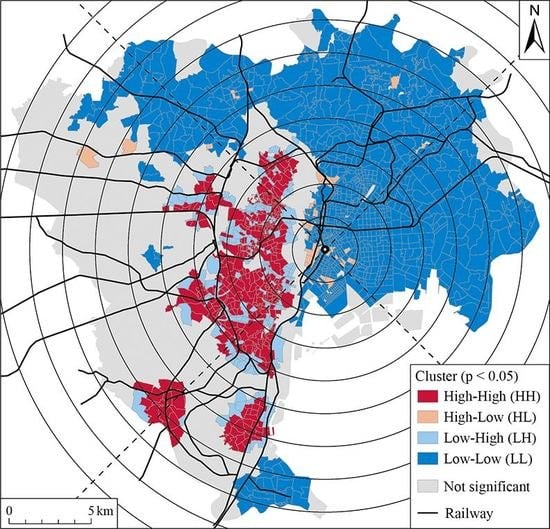An Examination of the Distribution of White-Collar Worker Residences in Tokyo and Osaka during the Modernizing Period
Abstract
:1. Introduction
2. Data and Methods
3. Results
3.1. Distributions of the Salaried Workers in 1925
3.2. Distributions of Company Employees and Executives based on Telephone Directories in the mid-1930s
3.3. Relationship Between Residences of the Company Employees and Executives and Distance from the City Center
4. Discussion
5. Conclusions
- As long as comparative statistical data were used, there was a tendency for many white-collar workers in clerical and technical positions to reside in certain sectors in both Tokyo and Osaka in 1925.
- In Tokyo and Osaka in the mid-1930s, the white-collar workers in private companies tended to live more in the urban fringes and suburbs with relatively low population density. Compared to Osaka, Tokyo was relatively suburbanized with white-collar workers in private companies.
Funding
Acknowledgments
Conflicts of Interest
References
- Gregory, I.N.; Healey, R.G. Historical GIS: Structuring, mapping and analysing geographies of the past. Prog. Hum Geog. 2007, 31, 638–653. [Google Scholar] [CrossRef]
- Gregory, I.N.; Geddes, A. (Eds.) Toward Spatial Humanities: Historical GIS and Spatial History; Indiana University Press: Bloomington, Indiana, 2014. [Google Scholar]
- McMaster, R.B.; Lindberg, M. The National Historical Geographic Information System (NHGIS). In Proceedings of the 21st International Cartographic Conference, Durban, South Africa, 10–16 August 2003; Volume 2003, pp. 821–828. [Google Scholar]
- Southall, H.; Přidal, P. Old Maps Online: Enabling global access to historical mapping. E-Perimetron 2012, 7, 73–81. [Google Scholar]
- Burgess, E.W. Residential Segregation in American Cities. Ann. Am. Acad. Pol. Soc. Sci. 1928, 140, 105–115. [Google Scholar] [CrossRef]
- Beveridge, A.A. Immigration, Ethnicity, and Race in Metropolitan New York, 1900–2000. In Past Time, Past Place: GIS for History; Knowles, A.K., Ed.; ESRI Press: Redlands, CA, USA, 2002; pp. 65–77. [Google Scholar]
- Gilliland, J.; Olson, S. Residential segregation in the industorializing city: A closer look. Urban Geogr. 2010, 31, 29–58. [Google Scholar] [CrossRef]
- Yano, K.; Nakaya, T.; Kawasumi, T.; Tanaka, S. (Eds.) Historical GIS of Kyoto; Nakanishiya: Kyoto, Japan, 2011. [Google Scholar]
- Statistics Bureau of Japan: Outline of the Grid Square Statistics, Compiled from the 2015 Population Census Results. Available online: https://www.stat.go.jp/english/data/mesh/pdf/h27outline.pdf (accessed on 9 August 2019).
- Kirimura, T. Building a database of the small area statistics about population of the six major cities in Japan: A first step to build a historical GIS database of modern Japanese cities. IPSJ Symp. Ser. 2011, 2011, 169–176. (In Japanese) [Google Scholar]
- Fujioka, H.; Okazaki, A. The emigration of the upper and middle classes of Tokyo to the suburban area between 1921 and 1931. Trans. AIJ. J. Archit. Plan. Environ. Eng. 1989, 405, 149–155. (In Japanese) [Google Scholar]
- Nozawa, S.; Lintonbon, J. Suburban taste. Home Cult. 2016, 13, 283–311. [Google Scholar] [CrossRef]
- Ueno, K. The residential structure of Tokyo in the 1910s (the Taisho Era). Geogr. Rev. Jpn. 1985, 58B, 24–48. [Google Scholar] [CrossRef]
- Mizuuchi, T. Formation and development of the inner city in Osaka during the Japanese industrialisation. Jpn. J. Hum. Geogr. 1982, 34, 385–409. [Google Scholar] [CrossRef]
- Statistics Bureau of Japan: What is a Densely Inhabited District? Available online: https://www.stat.go.jp/english/data/chiri/did/1-1.html (accessed on 9 August 2019).
- Tokyo City Office (Ed.) Tokyo Shi Toukei Nenpyo Dai 33 Kai (Statistical Yearbook of Tokyo City in 1935); Tokyo City Office: Tokyo, Japan, 1937; pp. 1–956. Available online: http://dl.ndl.go.jp/info:ndljp/pid/1710790 (accessed on 9 August 2019).
- Osaka City Office (Ed.) Osaka Shi Toukeisyo Dai 33 Kai (Statistical Yearbook of Osaka City in 1934); Osaka City Office: Osaka, Japan, 1936. Available online: http://dl.ndl.go.jp/info:ndljp/pid/1451466 (accessed on 9 August 2019).
- Cabinet Statistics Bureau (Ed.) Shitsugyou Toukei Chousa Houkoku Dai 1 Kan Kijutsu (Unemployment Census in 1925 Vol. 1); Cabinet Statistics Bureau: Tokyo, Japan, 1927; pp. 1–92. Available online: http://dl.ndl.go.jp/info:ndljp/pid/976223 (accessed on 28 June 2019).
- Nihon Syoko Tsushinsya (Ed.) Syokugyou-betsu Denwa Meibo Dai 25 Han (Classified Telephone Directory of 25th Edition in Tokyo); Nihon Syoko Tsushinsya: Tokyo, Japan, 1935; pp. 1–1144. Available online: http://dl.ndl.go.jp/info:ndljp/pid/1112313 (accessed on 28 June 2019).
- Osaka Central Telephone Office (Ed.) Osaka-Shi Oyobi Kinko Denwa Bango-Bo (Telephone Directory of Osaka City and Suburbs); Osaka Central Telephone Office: Osaka, Japan, 1937; pp. 1–874. [Google Scholar]
- Osaka City Office (Ed.) Osaka Shi Toukeisyo Dai 36 Kai (Statistical Yearbook of Osaka City in 1937); Osaka City Office: Osaka, Japan, 1939. Available online: http://dl.ndl.go.jp/info:ndljp/pid/1451614 (accessed on 9 August 2019).
- Laboratory of Geographical Information Sciences, Department of Geography, Tokyo Metropolitan University, Modern Tokyo Geocoding System. Available online: http://www.bokutachi.org/geocoding/index.php (accessed on 9 August 2019).
- Openshaw, S. The Modifiable Areal Unit Problem; CATMOG 38; Geo Books: Norwich, UK, 1984; pp. 1–41. [Google Scholar]
- Anselin, L. Local Indicators of Spatial Association—LISA. Geogr. Anal. 1995, 27, 93–115. [Google Scholar] [CrossRef]
- GeoDa. Available online: https://geodacenter.github.io/ (accessed on 9 August 2019).
- Cabinet Statistics Bureau (Ed.) Shitsugyou Toukei Chousa Sokuhou Taisho 14 Nen (Quick Bulletin of Result of 1925 Unemployment Census); Cabinet Statistics Bureau: Tokyo, Japan, 1925; pp. 1–11. Available online: http://dl.ndl.go.jp/info:ndljp/pid/976195 (accessed on 9 August 2019).
- Cabinet Statistics Bureau (Ed.) Kokusei Chosa Syokugyo Meikan Taisho 9 Nen (List of Occupation in 1920 Population Census); Cabinet Statistics Bureau: Tokyo, Japan, 1931; pp. 1–969. Available online: http://dl.ndl.go.jp/info:ndljp/pid/1464800 (accessed on 9 August 2019).










© 2019 by the author. Licensee MDPI, Basel, Switzerland. This article is an open access article distributed under the terms and conditions of the Creative Commons Attribution (CC BY) license (http://creativecommons.org/licenses/by/4.0/).
Share and Cite
Kirimura, T. An Examination of the Distribution of White-Collar Worker Residences in Tokyo and Osaka during the Modernizing Period. ISPRS Int. J. Geo-Inf. 2019, 8, 375. https://0-doi-org.brum.beds.ac.uk/10.3390/ijgi8090375
Kirimura T. An Examination of the Distribution of White-Collar Worker Residences in Tokyo and Osaka during the Modernizing Period. ISPRS International Journal of Geo-Information. 2019; 8(9):375. https://0-doi-org.brum.beds.ac.uk/10.3390/ijgi8090375
Chicago/Turabian StyleKirimura, Takashi. 2019. "An Examination of the Distribution of White-Collar Worker Residences in Tokyo and Osaka during the Modernizing Period" ISPRS International Journal of Geo-Information 8, no. 9: 375. https://0-doi-org.brum.beds.ac.uk/10.3390/ijgi8090375





